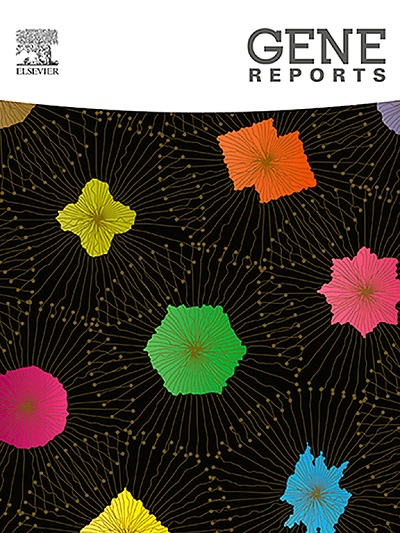Bioevaluation, pharmacokinetics and molecular docking study of terpenoid-rich rhizome essential oil of Zingiber officinale
IF 1
Q4 GENETICS & HEREDITY
引用次数: 0
Abstract
The study focuses on the phytochemical composition, in vitro and in silico antioxidant and NO reduction potential of Zingiber Officinale rhizome essential oil (ZOREO). The GC–MS analysis has revealed the presence of 47 volatile constituents representing 94.35 % of the total area of EO. The major compounds identified were α-zingiberene (20.58 %), geranial (10 %), β-sesquiphellandrene (7.39 %), and neral (7.23 %). The EO was rich in sesquiterpene hydrocarbons (45.93 %) followed by monoterpene hydrocarbons (29.29 %). The EO showed moderate antioxidant activity compared to the standard (IC50 = 5.16 ± 0.4 mg/mL for DPPH assay and EC50 = 0.52 ± 0.6 mg/mL for FRAP assay). The cytotoxic analysis showed significant viability towards RAW 264.7 cell lines. Treatment with ginger EO at a concentration of 100 μg/mL showed significant anti-inflammatory activity by the significant reduction of LPS-induced nitric oxide (NO) production to 31.35 %, in comparison with the LPS-treated group. Further, the EO components were screened in order to provide mechanistic insights into Xanthine oxidase (XO) and iNOS inhibition. The docking results showed that the volatile constituents of ginger EO have substantial binding affinity with the active site residues of the receptor. The simulation conducted for the top compounds- geranyl acetate and β-eudesmol having the highest binding affinity towards both the proteins XO and iNOS respectively. Both the results showed the compounds steadily interacted with both of the proteins active site residues throughout the simulation. The current analysis showed the phytoconstituents showed better antioxidant activity than the EO. Hence these compounds could be further considered for in vitro and in vivo evaluation for the development of efficient phytopharmaceuticals.
富含萜类化合物的细辛根茎精油的生物评估、药代动力学和分子对接研究
本研究主要探讨了银杏根茎精油(ZOREO)的植物化学成分、体外和硅学抗氧化及还原氮氧化物的潜力。气相色谱-质谱(GC-MS)分析显示,精油中含有 47 种挥发性成分,占精油总面积的 94.35%。鉴定出的主要化合物为α-zingiberene(20.58 %)、geranial(10 %)、β-sesquiphellandrene(7.39 %)和 neral(7.23 %)。环氧乙烷富含倍半萜烃(45.93 %),其次是单萜烃(29.29 %)。与标准物质相比,环氧乙烷显示出适度的抗氧化活性(DPPH 试验的 IC50 = 5.16 ± 0.4 mg/mL,FRAP 试验的 EC50 = 0.52 ± 0.6 mg/mL)。细胞毒性分析表明,生姜对 RAW 264.7 细胞株有显著的活力。用浓度为 100 μg/mL 的生姜环氧乙烷处理后,与 LPS 处理组相比,LPS 诱导的一氧化氮(NO)产生显著减少了 31.35%,从而显示出明显的抗炎活性。此外,还对环氧乙烷成分进行了筛选,以深入了解黄嘌呤氧化酶(XO)和一氧化氮(iNOS)的抑制机理。对接结果表明,生姜环氧乙烷的挥发性成分与受体的活性位点残基有很强的结合亲和力。模拟结果表明,乙酸香叶酯和β-桉叶油醇这两种顶级化合物分别与 XO 和 iNOS 蛋白的结合亲和力最高。这两项结果都表明,在整个模拟过程中,这些化合物都与这两种蛋白质的活性位点残基发生了稳定的相互作用。目前的分析表明,植物成分的抗氧化活性优于环氧乙烷。因此,可以进一步考虑对这些化合物进行体外和体内评估,以开发高效的植物药物。
本文章由计算机程序翻译,如有差异,请以英文原文为准。
求助全文
约1分钟内获得全文
求助全文
来源期刊

Gene Reports
Biochemistry, Genetics and Molecular Biology-Genetics
CiteScore
3.30
自引率
7.70%
发文量
246
审稿时长
49 days
期刊介绍:
Gene Reports publishes papers that focus on the regulation, expression, function and evolution of genes in all biological contexts, including all prokaryotic and eukaryotic organisms, as well as viruses. Gene Reports strives to be a very diverse journal and topics in all fields will be considered for publication. Although not limited to the following, some general topics include: DNA Organization, Replication & Evolution -Focus on genomic DNA (chromosomal organization, comparative genomics, DNA replication, DNA repair, mobile DNA, mitochondrial DNA, chloroplast DNA). Expression & Function - Focus on functional RNAs (microRNAs, tRNAs, rRNAs, mRNA splicing, alternative polyadenylation) Regulation - Focus on processes that mediate gene-read out (epigenetics, chromatin, histone code, transcription, translation, protein degradation). Cell Signaling - Focus on mechanisms that control information flow into the nucleus to control gene expression (kinase and phosphatase pathways controlled by extra-cellular ligands, Wnt, Notch, TGFbeta/BMPs, FGFs, IGFs etc.) Profiling of gene expression and genetic variation - Focus on high throughput approaches (e.g., DeepSeq, ChIP-Seq, Affymetrix microarrays, proteomics) that define gene regulatory circuitry, molecular pathways and protein/protein networks. Genetics - Focus on development in model organisms (e.g., mouse, frog, fruit fly, worm), human genetic variation, population genetics, as well as agricultural and veterinary genetics. Molecular Pathology & Regenerative Medicine - Focus on the deregulation of molecular processes in human diseases and mechanisms supporting regeneration of tissues through pluripotent or multipotent stem cells.
 求助内容:
求助内容: 应助结果提醒方式:
应助结果提醒方式:


